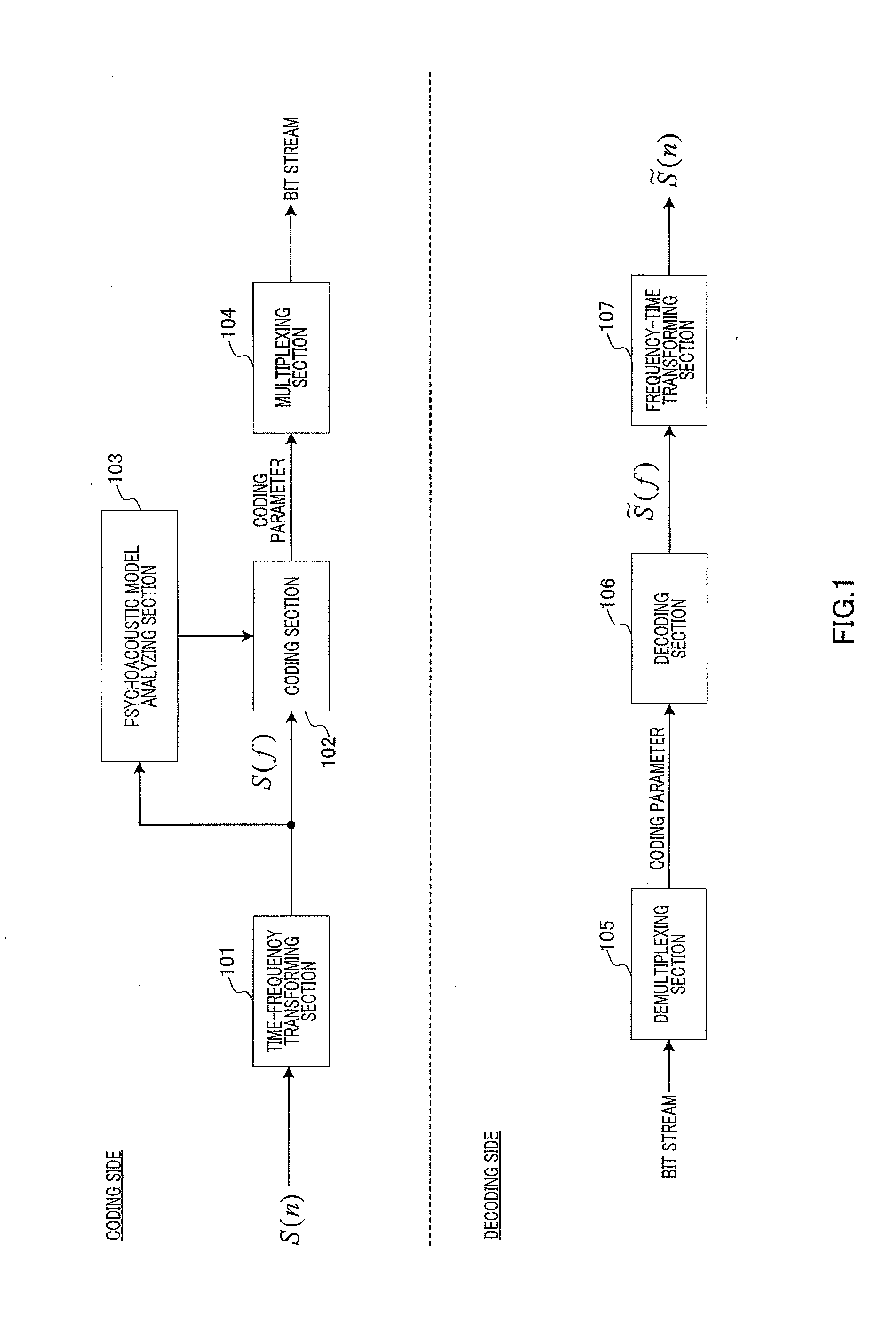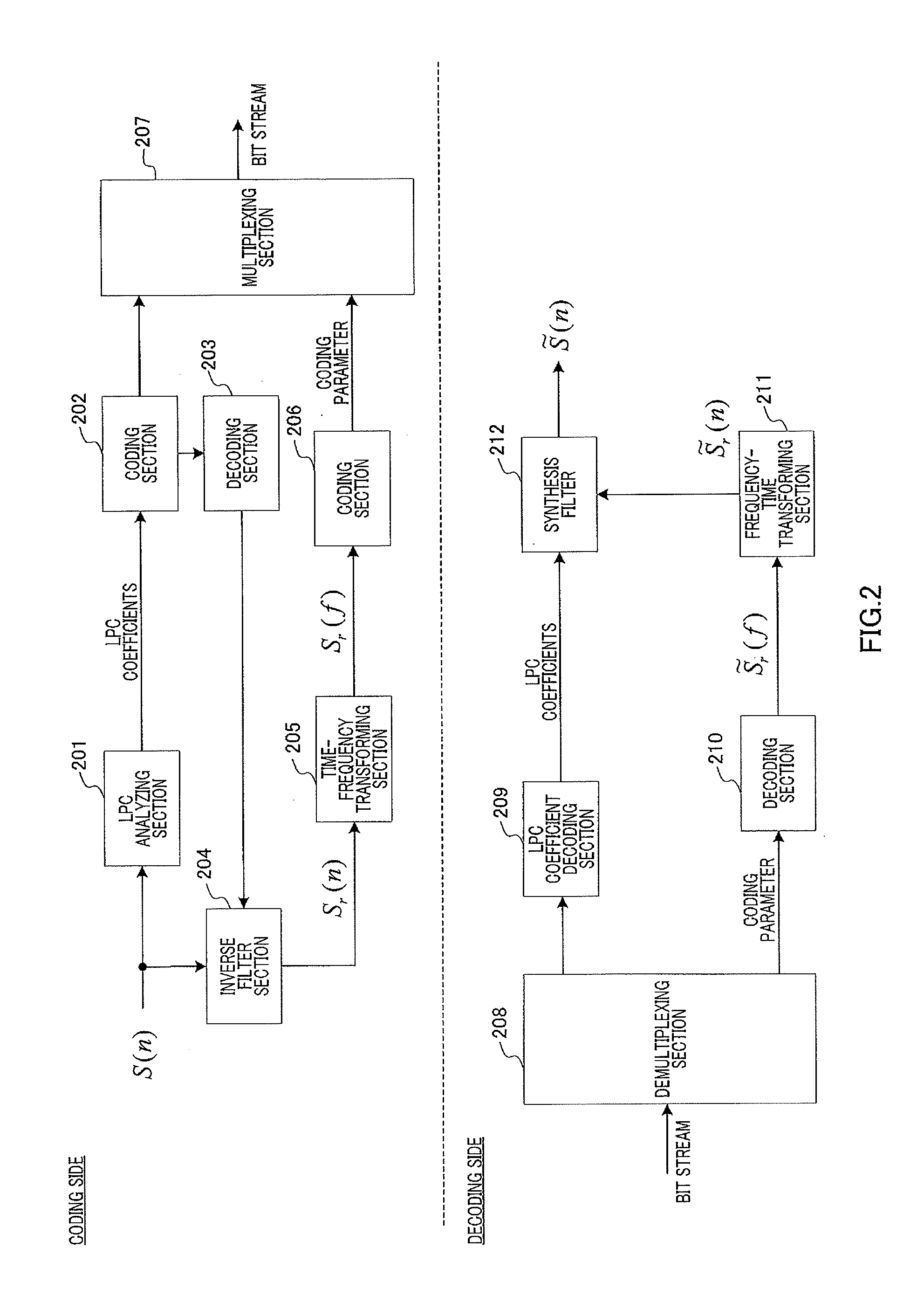Audio encoding apparatus and audio encoding method
a technology of audio encoding and speech, applied in the field of encoding speech apparatus and encoding speech, can solve problems such as difficult to obtain a psychoacoustic model, and achieve the effect of good sound quality
- Summary
- Abstract
- Description
- Claims
- Application Information
AI Technical Summary
Benefits of technology
Problems solved by technology
Method used
Image
Examples
embodiment 1
[0106]FIG. 10A illustrates a configuration of speech coding apparatus 1000A according to the present embodiment. FIG. 10B illustrates a configuration of speech decoding apparatus 1000B according to the present embodiment.
[0107]In the present embodiment, a pulse vector coding perceptually weights each spectral coefficient.
[0108]In speech coding apparatus 1000A (FIG. 10A), time-frequency transforming section 1001 transforms time domain signal S(n) into frequency domain signal S(f) (spectral coefficients), using time-frequency transformation such as discrete Fourier transform (DFT) or modified discrete cosine transform (MDCT).
[0109]Psychoacoustic model analyzing section 1002 determines a masking curve by performing a psychoacoustic model analysis on frequency domain signal S(f).
[0110]Perceptually-weighting section 1003 estimates perceptual importance levels based on the masking curve, and calculates respective weighting coefficients for the spectral coefficients according to the percep...
embodiment 2
[0127]FIG. 13A illustrates a configuration of speech coding apparatus 1300A according to the present embodiment. FIG. 13B also illustrates a configuration of speech decoding apparatus 1300B according to the present embodiment.
[0128]In the present embodiment, a TCX coding perceptually weights each spectral coefficient.
[0129]In speech coding apparatus 1300A (FIG. 13A), LPC analyzing section 1301 performs LPC analysis on an input signal, so as to use redundancy of a signal in a time domain.
[0130]Coding section 1302 encodes the LPC coefficients from LPC analyzing section 1301.
[0131]Decoding section 1303 decodes the encoded LPC coefficients.
[0132]Inverse filter section 1304 obtains residual (excitation) signal Sr(n) by applying an LPC inverse filter to input signal S(n) using the decoded LPC coefficients from decoding section 1303.
[0133]Time-frequency transforming section 1305 transforms residual signal Sr(n) into frequency domain signal Sr(f) (spectral coefficients) using time-frequency...
embodiment 3
[0151]FIG. 16A illustrates a configuration of speech coding apparatus 1600A according to the present embodiment. FIG. 16B also illustrates a configuration of speech decoding apparatus 1600B according to the present embodiment.
[0152]In the present embodiment, layer coding (scalable coding), in which a lower layer adopts a CELP coding and a higher layer adopts a transform coding, perceptually weights each spectral coefficient. In the following explanation, although the layer coding including two layers of the lower layer and the higher layer will be explained as an example, it is possible to apply the present invention to the layer coding including three layers or more.
[0153]In speech coding apparatus 1600A (FIG. 16A), CELP coding section 1601 performs a CELP coding on an input signal so as to use redundancy of a signal in a time domain.
[0154]CELP decoding section 1602 generates synthesized signal Ssyn(n) using the CELP parameter.
[0155]By subtracting the synthesized signal from the in...
PUM
 Login to View More
Login to View More Abstract
Description
Claims
Application Information
 Login to View More
Login to View More - R&D
- Intellectual Property
- Life Sciences
- Materials
- Tech Scout
- Unparalleled Data Quality
- Higher Quality Content
- 60% Fewer Hallucinations
Browse by: Latest US Patents, China's latest patents, Technical Efficacy Thesaurus, Application Domain, Technology Topic, Popular Technical Reports.
© 2025 PatSnap. All rights reserved.Legal|Privacy policy|Modern Slavery Act Transparency Statement|Sitemap|About US| Contact US: help@patsnap.com



